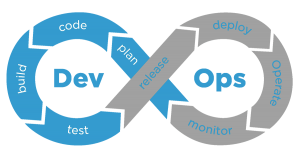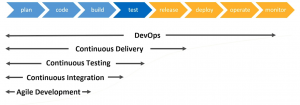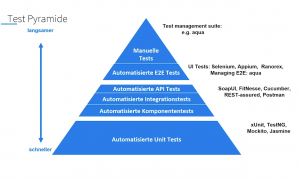What is continuous development?
Continuous development is a modernised approach to creating software and updating it. It preaches small upgrades with short lead time over big patches that take a while to put together. This approach is commonly used even for software that doesn’t rely on frequent updates to stay relevant.
You need quick feedback loops to make continuous development work, think 2-week sprints max, not quarterly releases. Scrum and Kanban aren’t just buzzwords here; they’re your safety net for shipping fast without breaking things.
You need to automate your testing pipeline first. You will improve deployment frequency nearly double within months. Your CI/CD tools should catch issues before they hit production with no exceptions. Start with one automated test suite this week. Even basic smoke tests beat manual checking every time. The goal is to ship daily without sweating bullets about what might break.
DevOps: Integration from Development to Sales

The term DevOps is very often used in modern software development. But what does it actually mean in principle? There is no clear answer to this question, because there are different interpretations and definitions. In general, however, it can be said that DevOps can be seen as an approach to process improvement that represents a change in corporate culture. Common processes and uniform tools should enable more effective and efficient collaboration. In the field of software development, this means close networking between planning, development, testing and sales.
You need quality checks baked in from the start, not tacked on later. When teams use BDD or ATDD, they’re essentially creating a shared language around “what done looks like” before anyone writes code.
Picture this: your product owner, developer, and tester sit down and hash out executable scenarios during requirements gathering. These become your automated acceptance criteria that actually guide development, not just validate it afterwards. Grab one upcoming feature and write three concrete scenarios using “Given-When-Then” format. Teams doing this report nearly 40% fewer defects reaching production, mainly because everyone’s working toward the same definition of success from day one.
The Path to Continuous Develoment

Individual terms or processes that are subordinate to the topic of DevOps are Continuous -Integration, -Testing and -Delivery. These modern working methods in software development build on each other. Continuous Integration describes a process of continuously assembling components into an application. In testing, test cases are also continuously integrated into this process, which guarantees a high quality of the software already during the development process. This means that not only is an up-to-date status available at all times, but also an actually functioning status. Finally, continuous delivery describes the possibility of being able to provide the user with an up-to-date, defect-free version of the software at any time. DevOps encompasses all these areas and represents the interaction between all departments involved in the development process.
Best Practices: Building Quality into the CI/CD Pipeline
DevOps test management is about weaving quality checks throughout your entire pipeline. The Test Automation Pyramid is your best friend here: stack most of your automated tests at the unit and integration levels where they run fast and catch issues early. Then sprinkle in just enough end-to-end UI tests to cover critical user flows.
Automated quality gates stop deployments cold when code coverage drops below 80% or performance tests show slowdowns. Your environments should be provisioned as code, too, no more ‘it works on my machine’ headaches when tests behave differently across environments.
Pick code coverage since it’s straightforward to implement and gives immediate feedback. Once that’s running smoothly, you can expand to include performance thresholds and security scans. Your goal is to make sure every single commit gets validated for both correctness and speed before it even thinks about reaching production.
Agile Test Management as a Part of the Process
As stated before, agile testing also plays a decisive role in the topic of DevOps. Both testers and developers are dependent on fast and direct feedback in order to be able to provide the software at any time without defects and in the latest version. A good implementation of the testing in the “DevOps pipeline” is particularly important for this. It must always be ensured that deployments have successfully passed all tests before delivery.
A prerequisite for this is that, in addition to good test coverage, importance is also attached to the speed of the tests. Automated tests in particular play an important role in this context. However, manual testing cannot be dispensed with entirely, because not all tests can be automated. It is therefore important to be able to combine different types of tests optimally and integrate them into the development process. A holistic test management tool that can orchestrate the various tests and summarize the results centrally is ideal for this purpose.

Challenges for quality assurance
In summary, it is clear that test management under DevOps must deliver results when they are needed. This is basically only possible if the tests are integrated into an agile development process and test management itself follows agile patterns.
In addition to the already mentioned integration into the DevOps pipeline and the orchestration of the different types of tests, the overview of the project, i.e. transparency, is ultimately also very important. This is only given if all data is managed centrally and an optimal evaluation, analysis and control of the project and QA can take place. Here, too, it is clear that a holistic tool is a decisive factor, especially if you’re taking the Agile for DevOps route.
Overall, it can be seen that the demands on the entire team increase with agility and methods such as DevOps, but that there are great advantages in return. While conservative methods such as the waterfall model rarely allowed new software releases, updates can now be delivered in a very short time. Agile practices for DevOps amplify these gains.
If you’re looking for a test management system to work by Agile, aqua has you covered. It is a proven and powerful solution to create tests, execute them, and track your QA success. The AI-powered testing functionality allows you to auto-create entire tests for a requirement and make them up-to-date when the requirement changed.
Get AI-powered test management system
Edge Cases and How Modern Teams Address Them
Even as Agile and DevOps mature, teams face recurring challenges that can derail their best efforts. Flaky tests that undermine trust in automation. Test data that’s a complete mess. Complex legacy systems that refuse to play nice with your shiny new code.
You need to treat flaky tests like they’re critical bugs — because they are. High-performing teams quarantine them immediately and dig into root causes. Usually, it’s unstable environments or race conditions that you can actually fix. For test data chaos, automated scripts that generate fresh, relevant datasets beat manual data wrangling nearly every time.
Legacy system headaches? Service virtualisation and adapter patterns can bridge that gap between old and new without making your tests dependent on external systems that go down at the worst possible moment. One concrete first step: identify your three flakiest tests this week and dedicate time to understanding why they fail.

















